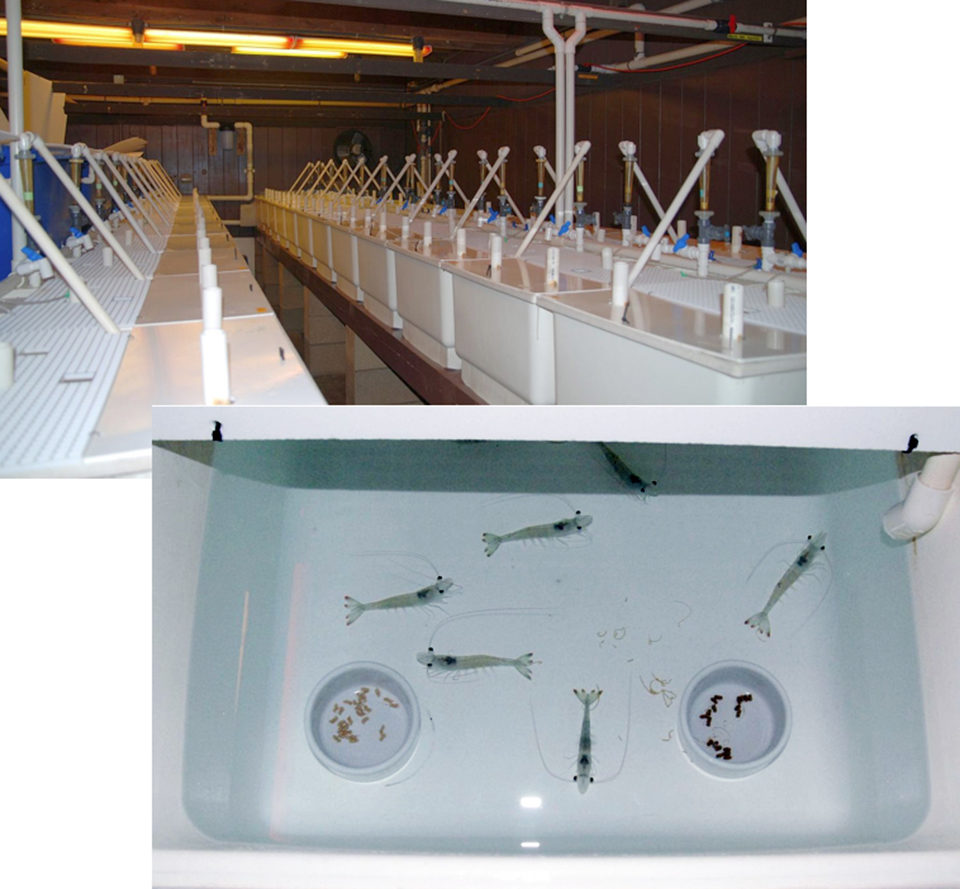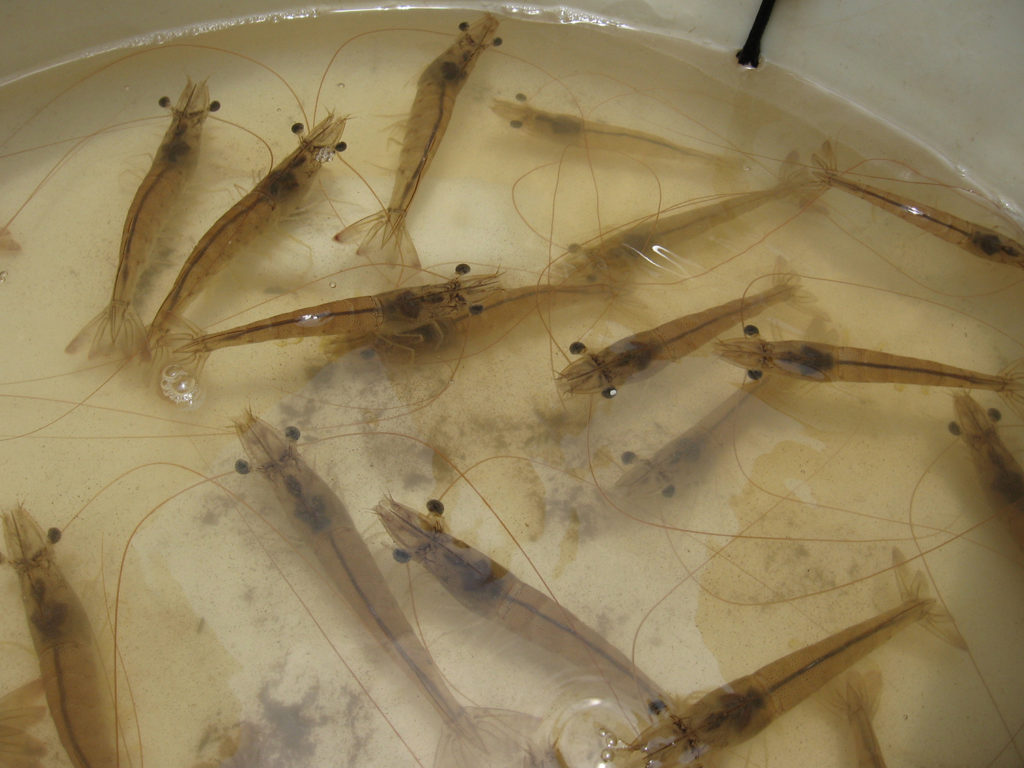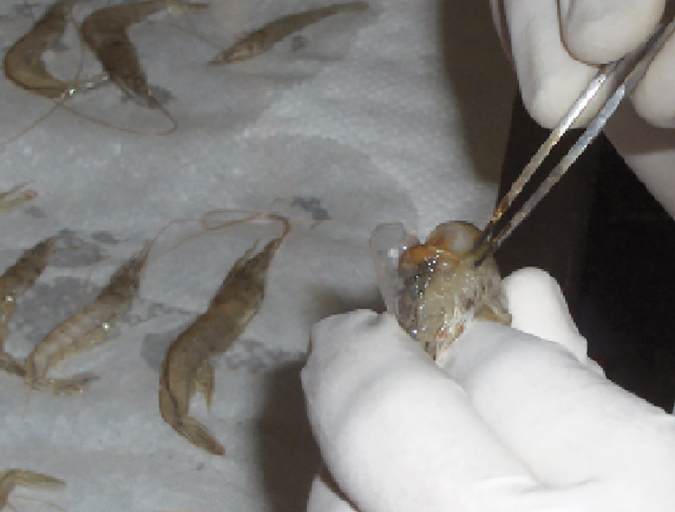Effectiveness of byproducts depends on inclusion levels

Feed palatability or attractability becomes a concern when marine fishmeal or fish oil is replaced by plant protein or plant oil in aquatic feeds. Diet supplementation with feeding stimulants is a common approach to maintaining palatability in aquafeed.
Purified chemicals such as amino acids and nucleotides, and extracts from marine organism have been widely used as feeding stimulants in shrimp feeds. These products, however, can be expensive or limited in availability. Other cost-effective and available additives will be needed to meet the increasing demand for feeding stimulants by aquatic feed producers.
Fishery byproducts
The fishery of the United States’ northernmost state, Alaska, is the largest in the world, with nearly 1.86 million metric tons (MT) of fish and shellfish harvested in 2009. Although up to 70 percent of this volume was recovered for human food production, the fishery also generated a significant volume of byproducts. Most of the fishery by-products were not well utilized and became waste.
Studies have shown that a lot of those byproducts, such as viscera and frames, contained not only good level of proteins, but also other compounds like peptides and other solubles, which can function as feeding stimulants for fish or shrimp.
The authors recently carried out a study to evaluate the effects of the Alaskan fisheries byproducts on feeding responses of Pacific white shrimp fed a plant protein-based diet. The study was funded through a grant from the U.S. Department of Agriculture Agricultural Research Service and a cooperative agreement with the University of Alaska-Fairbanks.
Feeding study
Nine Alaskan fisheries byproducts from commercial fish-processing plants in Kodiak, Alaska, were supplied by the University of Alaska’s Fishery Industrial Technology Center (Table 1). All by-products were dried, milled and stored frozen until use. A reference diet was formulated with 75 percent soybean meal and 25 percent whole hard red winter wheat.
Conquest, Proximate composition of ingredients, Table 1
| Ingredient | Moisture (g/kg) | Protein (g/kg) | Lipid (g/kg) | |
|---|---|---|---|---|
| Soybean meal | 66.5 | 483.0 | 18.6 | 71.6 |
| Hard red winter wheat | 85.7 | 139.3 | 18.3 | 16.7 |
| Pollock bones | 127.8 | 380.9 | 40.8 | 416.4 |
| Tanner crab carapaces and viscera | 49.4 | 358.6 | 87.0 | 282.4 |
| Pink salmon livers | 102.7 | 686.3 | 102.0 | 41.4 |
| Pink salmon milt | 85.3 | 845.5 | 30.3 | 124.9 |
| Arrowtooth heads, viscera | 112.8 | 329.7 | 370.7 | 105.0 |
| Black cod viscera | 293.3 | 365.8 | 198.3 | 35.1 |
| Dried skate | 72.4 | 875.6 | 18.1 | 118.2 |
| Salmon heads, smoked | 29.0 | 576.0 | 276.0 | 109.0 |
| Salmon heads, smoked and fermented | 18.0 | 553.0 | 209.0 | 92.0 |
| Commercial diet A | 94.4 | 404.8 | 77.8 | 92.6 |
| Commercial diet B | 97.0 | 416.1 | 79.2 | 94.0 |
The test diets were formulated by replacing the reference diet with 3.0 percent or 5.0 percent of a byproduct. A commercial diet with 40.0 percent protein and 2.5 percent squid meal was included in each trial as a positive control. The diets were pelleted to a size of 2.4 x 3.0 mm for the feeding trial.
The water stability of the pellets was measured in saltwater at 25 degrees-C in triplicate using a static method. Feed was weighed into a 250-mL flask with 100 mL of seawater and left undisturbed for one hour before retention of dry matter was measured.
All trials were conducted in flow-through tanks equipped with 55 L of 25 degrees-C seawater with 31 ppt salinity. There were 10 shrimp per tank with five or six replicates per dietary treatment. Individual shrimp ranged from 7.4 to 9.9 grams. The feed consumption was monitored for four consecutive days for each trial. Feeding stimulus was measured once daily for four consecutive days.
Each tank had one bowl for the reference diet and another bowl for a test diet. Twenty-five pellets of a diet were loaded into each bowl. The shrimp were allowed to feed for 60 minutes before the remaining pellets were counted. To avoid interference from a rheotactic response, air and water flow were discontinued one hour prior to feeding and restored immediately after the assessment. After the test, the feed and bowls were removed, and an additional bowl was placed in the tank for the overnight feed.
Results
The proximate composition varied significantly among different by-products (Table 1). Protein levels ranged from 330 to more than 850 g/kg. Lipid levels were between 18.1 and 370 grams per kg. The water stability of the pellets was not significantly affected by supplementation of the by-products (Table 2).
Conquest, Pellet water stability, Table 2
| Trial 1 | |||||
| Pollock bones (50 g/kg) | 88.5 | 18.3 ± 7.2 | 8.8 ± 2.9 | 9.5 | No |
| Tanner crab carapaces and viscera (50 g/kg) | 88.7 | 20.5 ± 8.4 | 5.2 ± 3.6 | 15.3 | No |
| Pink salmon livers (50 g/kg) | 87.8 | 27.5 ± 10.5 | 11.3 ± 7.2 | 16.2 | Yes |
| Pink salmon milt (50 g/kg) | 89.9 | 16.0 ± 6.4 | 12.8 ± 4.5 | 3.2 | No |
| Commercial diet A | 90.0 | 29.0 ± 2.4 | 3.3 ± 1.8 | 25.7 | Yes |
| Trial 2 | |||||
| Arrowtooth flounder heads, viscera (30 g/kg) | 89.0 | 21.6 ± 8.7 | 12.2 ± 4.7 | 9.4 | No |
| Arrowtooth flounder heads, viscera (50 g/kg) | 84.8 | 27.2 ± 9.9 | 8.2 ± 2.8 | 19.0 | Yes |
| Black cod viscera (30 g/kg) | 87.7 | 18.2 ± 5.9 | 3.2 ± 1.0 | 15.0 | No |
| Black cod viscera (50 g/kg) | 85.9 | 30.2 ± 4.9 | 9.0 ± 1.9 | 21.2 | Yes |
| Dried skate (30g/kg) | 89.9 | 14.4 ± 5.7 | 7.6 ± 3.6 | 6.8 | No |
| Dried skate (50 g/kg) | 86.9 | 16.2 ± 2.8 | 4.2 ± 2.3 | 12.0 | Yes |
| Commercial diet B | 86.9 | 25.6 ± 5.2 | 7.6 ± 4.1 | 18.0 | Yes |
| Trial 3 | |||||
| Salmon heads, smoked (30 g/kg) | 90.4 | 7.3 ± 1.9 | 3.7 ± 2.0 | 3.7 | No |
| Salmon heads, smoked (50 g/kg) | 89.4 | 12.7 ± 5.5 | 4.3 ± 1.0 | 8.3 | No |
| Salmon heads, smoked and fermented (30 g/kg) | 85.8 | 5.5 ± 2.0 | 0.8 ± 0.7 | 4.7 | No |
| Salmon heads, smoked and fermented (50 g/kg) | 87.8 | 12.5 ± 6.2 | 1.5 ± 1.0 | 11.0 | Yes |
| Commercial diet B | 86.9 | 15.5 ± 2.1 | 2.0 ± 1.4 | 13.5 | Yes |
** Response = Number of test pellets consumed – number of reference pellets consumed Salmon heads provided by Dr. C. K. Bower.
Table 2. Pellet water stability and feeding responses of shrimp fed test diets.
The stimulus response for each ingredient was measured based on the difference between the numbers of pellets of each diet consumed. The feeding responses of shrimp fed the test diets were similar to the feeding responses of shrimp fed the commercial diet.
A significant feeding response was observed for the following ingredients when they were added at a level of 50 grams per kg diet: pink salmon livers, arrowtooth flounder heads and viscera, black cod viscera, dried skate and fermented-smoked salmon heads (Table 2). The addition of smoked salmon heads without fermentation did not show this effect. The by-products from fish bones and crab carapaces also did not yield a positive response in feeding.
Perspectives
Feed attractability is known to be affected by the composition of the feed ingredients and the leaching rate of soluble compounds such as amino acids, nucleotides, low-molecular-weight amines and organic acids, which had positive effects on crustacean feeding behavior. The byproducts made from fish livers, heads and/or viscera might contain similar compounds that enhance feeding responses in Pacific white shrimp.
The authors did not identify which components of the byproducts functioned as the feeding stimulants in this study. Further investigation is needed to elucidate the stimulant components in the byproducts. Results of the study also showed that the effectiveness of the byproducts as feeding stimulants depended on their inclusion levels as well as processing method used to prepare the ingredients. Post-smoking fermentation significantly improved the feeding response in shrimp, which suggested that different post-processing methods can increase the potential of a byproduct.
(Editor’s Note: This article was originally published in the March/April 2012 print edition of the Global Aquaculture Advocate.)
Authors
-
Lytha Conquest
The Oceanic Institute
Aquatic Feeds and Nutrition Department
41-202 Kalanianaole Highway
Waimanalo, Hawaii 96795 USA[103,114,111,46,101,116,117,116,105,116,115,110,105,99,105,110,97,101,99,111,64,116,115,101,117,113,110,111,99,108]
-
Dong-Fang Deng, Ph.D.
The Oceanic Institute
Aquatic Feeds and Nutrition Department
41-202 Kalanianaole Highway
Waimanalo, Hawaii 96795 USA -
Warren G. Dominy, Ph.D.
The Oceanic Institute
Aquatic Feeds and Nutrition Department
41-202 Kalanianaole Highway
Waimanalo, Hawaii 96795 USA -
Peter J. Bechtel, Ph.D.
USDA Agricultural Research Service
Subarctic Agricultural Research Unit
Fishery Industrial Technology Center
Kodiak, Alaska, USA -
Scott Smiley, Ph.D.
Fishery Industrial Technology Center
School of Fisheries & Ocean Sciences
University of Alaska
Kodiak, Alaska, USA
Tagged With
Related Posts

Health & Welfare
A holistic management approach to EMS
Early Mortality Syndrome has devastated farmed shrimp in Asia and Latin America. With better understanding of the pathogen and the development and improvement of novel strategies, shrimp farmers are now able to better manage the disease.

Health & Welfare
Cost-effective biosecurity crucial for shrimp farming
Many shrimp producers give only perfunctory attention to routine biosecurity at hatcheries and farms. A cost-effective biosecurity program for farmed shrimp requires reliable diagnostic tools to make timely decisions to control or exclude pathogens.

Intelligence
Current production, challenges and the future of shrimp farming
At the Guatemalan Aquaculture Symposium in Antigua, the focus was shrimp farming in the region: production, nutrition, health management and markets.

Health & Welfare
Double-stranded RNA against WSSV genes provides antiviral protection in shrimp
Silencing genes in white spot syndrome virus (WSSV) with critical roles in replication could provide a strong antiviral effect and thus reduce shrimp mortality. The authors therefore established a study to evaluate the antiviral efficacy of double-stranded (ds)RNA against non-structural WSSV genes.


